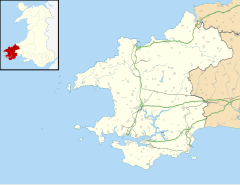Abercastle
Abercastle
| |
|---|---|
 | |
Location within Pembrokeshire | |
| Principal area | |
| Country | Wales |
| Sovereign state | United Kingdom |
| Post town | Haverfordwest |
| Postcode district | SA62 |
| Police | Dyfed-Powys |
| Fire | Mid and West Wales |
| Ambulance | Welsh |
| UK Parliament | |
| Senedd Cymru – Welsh Parliament | |
Abercastle (Welsh: Abercastell) is a village in Pembrokeshire, Wales. Abercastle has a working harbour which is managed by Abercastle Boat Owners Association.
In 1876, The harbour was the landing-site of the first Atlantic Ocean single-handed sailing, west-to-east, starting from Gloucester, Massachusetts, by Alfred "Centennial" Johnson.[1]
History
[edit]Abercastle is an old trading harbour which exported local slate and grain, limestone, butter, honey, corn, and some coal. There are also the remains of nineteenth century limekilns.[2]
Alfred Johnson memorial
[edit]
Alfred Johnson landed at Abercastle on Saturday, August 12, 1876, after 66 days sailing from Gloucester, Massachusetts, becoming the first person to make the single-handed Atlantic crossing.[3] Johnson, a Danish born fisherman used a small dory named 'Centennial'. He managed an average pace of about 70 miles (110 km) a day, quite respectable for such a small boat in the open sea, and survived a gale which capsized the boat.[3]
A plaque made of Welsh Slate is on the quay wall near the slipway and was unveiled by Alfred Johnson's grandson, Charlie Dickman on 17 October 2003.[3] Local author Rob Morris has also written a book about the crossing called Alfred "Centennial" Johnson.[3] St Davids poet Tony Davies also dedicated the following to Alfred Johnson:
Sixty six days, three thousand miles,
Record breaking, Abercastle smiles,
Liverpool, trip complete,
The courage of Captain Johnson and Centennial’s feat.[3]
Carreg Samson
[edit]
Carreg Samson, also known as 'Carreg Sampson', Samson's Stone and the 'Longhouse' is a 5,000-year-old Neolithic Burial Chamber and the site of over 1,000 burials. Half a mile west of the Abercastle near the Pembrokeshire Coast Path, it has a cap stone 15 feet long and 9 feet wide supported on three of the seven upright stones. It is thought to have been a portal dolmen and was built over a pit.[4] It is called 'Samson' because of a local legend that Samson placed it in position with his little finger.[5] The whole burial chamber was once covered by a mound of earth or stones and once these were removed stones were used to block the holes in the sides of the tomb so that it could be used as a shelter for sheep.[6] Excavations in 1968 found an early Neolithic bowl.[7]
Facilities
[edit]The harbour faces northwest and is therefore sheltered from south-westerly gales, providing a safe haven for the local fishing fleet. There is a public telephone and free parking for a small number of cars. The slipway goes to soft sand and is not suitable for non off-road vehicles.[8] The coastal bus “The Strumble Shuttle” calls at Abercastle.
Activities
[edit]
Popular for fishing and diving, there are also several recorded climbing sites in the area although they are suitable for group use. The harbour is a good launching site for sea kayaking. The coastal path that follows the coast of Pembrokeshire passes through Abercastle, and is popular with tourists and local walking groups.
Shipwreck
[edit]The 3,800 ton wreck of SS Leysian lies on the west side of the harbour, about 50m from the cliffs. She ran aground and sank a few months later in 1917 with no loss of life. As it is at a depth of around 15m the wreck is popular with divers who report much wreckage, and a large range of fish, including a large pollock which lives in the wreck. A detailed survey of the wreck began in June 2019.[9][10][11]
-
The harbour
-
A cottage overlooking the harbour
-
A lime kiln
-
Plants near the harbour wall path
-
Ynys y Castell
-
Looking towards the village
References
[edit]- ^ Morris, Robert (October 2003). Alfred Centennial Johnson: The Story of the First Solo Atlantic Crossing from West to East in 1876. Y Crofft. ISBN 978-0-9547351-0-4.
- ^ "Abercastle". Archived from the original on 28 October 2009. Retrieved 10 November 2009.
- ^ a b c d e Morris, Rob. "Alfred "Centennial" Johnson". Archived from the original on 15 May 2008. Retrieved 14 November 2009.
- ^ "Carreg Samson". Archived from the original on 13 July 2011. Retrieved 14 November 2009.
- ^ "Carreg Samson". Retrieved 10 November 2009.
- ^ "Carreg Samson". Retrieved 10 November 2009.
- ^ "Celia Haddon Standing Stones". Archived from the original on 22 November 2009. Retrieved 10 November 2009.
- ^ "Abercastle". Archived from the original on 5 April 2010. Retrieved 10 November 2009.
- ^ "Dive Pembrokeshire". Retrieved 10 November 2009.
- ^ "Abercastle Bay shipwreck: divers begin SS Leysian study". BBC News. 8 June 2019. Retrieved 8 June 2019.
- ^ "Nautical Archaeology Society Field School: Abercastle, 7–17 June 2019". Retrieved 8 June 2019.







